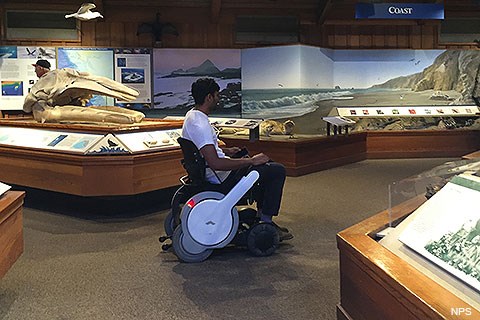|
All of Point Reyes National Seashore's Visitor Centers are accessible. Point Reyes also has numerous accessible paths to various points of interest. Brief descriptions of some of the park's accessible points of interest may be found below. The National Seashore has a limited number of copies of the text from the park's official map/brochure in Braille format available at the Bear Valley Visitor Center. You may also download the Braille Ready File version of our official map/brochure (11 KB BRF) for printing at home on your Braille embosser/printer. 
Visitor CentersBear Valley Visitor CenterThe Bear Valley Visitor Center is mostly accessible with a gently ramped, multilevel interior. Most displays are well placed for use or viewing from a seated position. Restrooms are accessible. Designated parking is located in front of the center. Point Reyes Lighthouse Visitor CenterThe Lighthouse Visitor Center, observation deck, and restrooms are all fully accessible, but the lighthouse itself is not. More detailed information is available in the Accessibility section on our Visit the Point Reyes Lighthouse page. Kenneth C. Patrick Visitor Center and Drakes BeachThe complex includes the Kenneth C. Patrick Visitor Center, PRNSA Bookstore at Drakes Beach, picnic area, and restrooms, which are all accessible. A beach wheelchair for Drakes Beach is available upon request. There are several designated parking spaces. There are no paths leading down to the beach from the parking lot that meet accessibility standards at this time. TrailsEarthquake TrailThis 1 kilometer (0.6 mile) round-trip paved trail is self-guiding. The asphalt pathway was designed to be accessible, but over the years since it was last paved, depressions have developed in a number of locations or one side of the pathway has dropped which precludes the pathway from currently meeting criteria for being fully accessible. Some wheelchair users may need assistance to navigate through these degraded sections of the trail. An accessible restroom and two designated parking spaces in a dirt/gravel parking lot are located at the trailhead. Bear Valley Trail to Divide Meadow(Assistance required.) Five Brooks Pond(Assistance advisable.) Historic Pierce RanchA soil cement trail tours this dairy ranch, located on Tomales Point, that was established in 1858. BeachesLimantour BeachA paved trail leads ~225 meters (~725 feet) from the accessible parking area past a small picnic area, over a bridge spanning wetlands, and toward the beach before encountering a sand dune that will prevent passage to those in most wheelchairs from accessing the beach. Vault toilets are not accessible. Drakes, North, and South BeachesEach parking lot has an accessible restroom and designated parking. There are short, paved paths along the edge of the parking lots with lovely ocean views. A beach wheelchair for Drakes Beach is available upon request. There are no paths leading down to these beaches from the parking lots that meet accessibility standards at this time. Other Points of InterestHistoric Chimney Rock Lifeboat StationVolunteers often staff the Historic Boathouse near Chimney Rock on weekends and holidays from January through March. At other times, visitors may explore the Lifeboat Station grounds, where wayside exhibits provide information about the U.S. Lifesaving Service and U.S. Coast Guard history at Point Reyes. The boathouse's first floor and boat bay are wheelchair accessible. There is also an accessible restroom within the boathouse. Individuals with a Disabled Person parking placard or plate may drive their personal vehicle to the boathouse parking area. Morgan Horse RanchWith a Disabled Person parking placard or plate, you may drive your vehicle along the maintenance road to a small parking area close to the stables at the Morgan Horse Ranch. Exhibit areas are accessible. Mount VisionA fifteen minute drive up winding Mount Vision Road off Sir Francis Drake Highway takes you to three spectacular vista points (on clear days). Two viewpoints look west towards Drakes Bay and Estero and one near the top looks east over Tomales Bay. No facilities. Point Blue Conservation Science's Palomarin Field StationFormerly known as PRBO Conservation Science and the Point Reyes Bird Observatory, this research station in the south end of the park has a small visitor center with accessible restrooms. Bird banding can be observed from sunrise until noon. Call 415-868-0655 for information or go to their website. Service AnimalsAt National Park Service sites, only dogs are classified as service animals, and they must perform a specific task that assists a person with a disability. Emotional support or comfort animals are not service animals. Additional information is provided on this park's Service Animals page and on the national Service Animals in National Parks page. Visiting other National Park Service sitesThe National Park Service is committed to ensuring that people with disabilities have equal opportunity to benefit from our facilities, programs, services, and activities whether they are indoors or outdoors. Discover accessible features in parks and learn more about what we do to provide accessibility across the National Park System. Some other parks may also have mobility devices available for loan for use on beaches and trails. Read More |
Last updated: August 6, 2025
